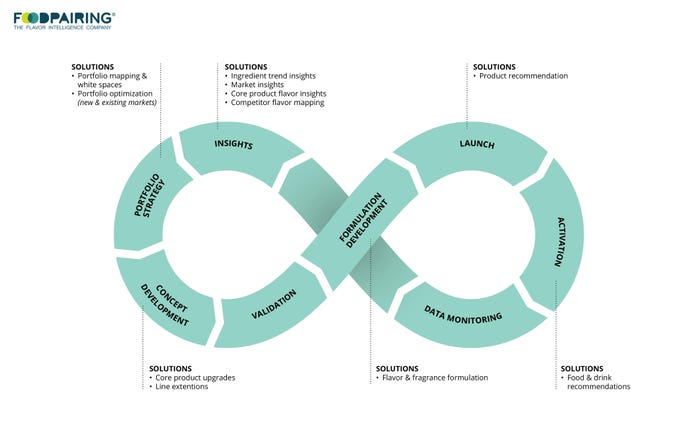Belgian-based Foodpairing is a foodtech scale-up that believes flavour is a key enabler in solving particular global challenges, such as obesity. The company was founded on the premise that it believes flavour can succeed where other solutions have failed.
For example, Foodpairing’s founder, Bernard Lahousse, saw that flavour and flavour technology was a key enabler to help make the shift from cow milk to plant-based soy milk possible by eliminating the off-flavours of soy. However, this transition took more than 30 years.
“Today, unfortunately, we do not have 30 years anymore to solve certain pressing global challenges,” says Bernard Lahousse, founder of Foodpairing.
As a result, Foodpairing sought to combine its flavour knowledge and data with artificial intelligence (AI) technology to speed things up. The brand’s mission is to accelerate the world’s transition to healthier and more sustainable food because it believes “good food is good business”.
Image: Foodpairing FlavorID profile sample
Addressing the obesity crisis: ‘Flavour is a key criterion’
Numerous studies have shown a diet’s positive influence, including various fruits and vegetables, amongst other food categories, on addressing obesity, Lahousse notes.
“However, many consumers do not have actionable information available to make positive food choices,” says Lahousse.
Socioeconomic and food literacy factors may also impact people’s decision-making regarding healthy food choices.
For parents, there is the additional challenge of helping their children eat healthily, Lahousse says. In 2016, over 340 million children between the ages of 5-19 around the world were overweight or obese, the World Health Organization (WHO) says. In 2019, the WHO reported that an estimated 38.2 million children under five years old were overweight or obese.
“And while diet programmes highlight the benefits of eating healthier, this does not necessarily translate into a consistent change in consumption patterns,” says Lahousse. “Some may find diets are too burdensome or too dramatic of a change for their everyday lives, making it less likely that they will keep motivated and persist,” Lahousse adds.
While diets may show the benefits of healthier eating, they do not necessarily result in behavioural change. Foodpairing strongly believes that flavour could be the entry point for this change.
“We see flavour as a key criterion for shifting people’s habits toward new, healthy and sustainable foods repeatedly,” says Lahousse.
A pilot was set up to prove this hypothesis. Science and technology in childhood Obesity Policy (STOP) is a four-year horizon project that commenced in 2020 and will work to uncover policy changes needed to address childhood obesity across Europe. In its pilot under the STOP project, Foodpairing worked to support families with obese children to develop healthier eating behaviours, taking into consideration their flavour preferences, using a proprietary FlavorID platform.
The ‘flavour passport’: Using technology to understand eating habits
Foodpairing’s flavorID technology platform is designed to help consumers understand their flavour preferences. Through answering a series of surveys, the flavorID platform can determine an individual’s flavour preferences and their likes and dislikes. The platform does this by understanding it at a molecular level, considering thousands of ingredient and aroma component options.
The results of the surveys serve as a ‘flavour passport’, Lahousse says, allowing individuals to identify their taste preferences and novel ingredients, recipes and swaps based on their taste profile. The platform also calculates a health scoring, providing inputs for future decision-making that can impact long-term health and wellness.
Based on their flavour preferences identified via flavorID, the platform recommends go-to recipes and regular updates based on each family’s and family members’ flavour preferences. Using the platforms, families could also access step-by-step recipe guidance and data-driven recommendations for adding and swapping different fruits and vegetables.
New product development needs to be smart, data-driven and agile
Food manufacturers can also utilise Foodpairing’s go-to-recipe platform and flavorID technology to create their products with health-consciousness at the forefront of their formulations.
“Consumer Packaged Goods (CPG) are facing substantial challenges today,” says Lahousse. People want to eat healthier and more sustainably. “Therefore, a portfolio transition is needed [with] less fat, sugar, salt, pushed by regulatory bodies and Environmental, Social and Governance (ESG) goals by governments,” adds Lahousse.
The onset of the Covid-19 pandemic has highlighted the need for technology-based solutions to provide a foundation for formulation development and production.
“Covid has increased the need for a digital transformation of the new product development (NPD) process,” Lahousse says. “The process needs to be smart, data and AI-driven and agile,” Lahousse continues.
Foodpairing is striving to help with these challenges by building an AI-powered platform to help CPGs build better products faster. The brand settled on transforming the traditional stage-gate development process into an infinity loop to reflect its process, which starts from the assumption that no product is finished.

Image: Foodpairing Infinity Loop
Developing technology to tackle childhood obesity
“The challenge of combating childhood obesity is complex and multifaceted,” says Lahousse.
There is no one-size-fits-all solution. To effectively combat childhood obesity, Foodpairing believes a multidisciplinary approach is needed to address several areas, including food and nutrition, health behaviours, agrifood environments, socioeconomic barriers and policy making.
“However, we believe our technology can address this challenge from a new angle—healthier food that tastes good,” says Lahousse.
A number of potential applications include flavorID being used to create personalised dietary recommendations for individuals and groups for people with concerns relating to obesity, cholesterol or diabetes. It also has the potential to improve meal recipes to meet dietary goals by suggesting nutrient-rich swaps. In addition, Foodpairing sees its flavorID technology as helping to improve patient care through flavour preference analysis, for example, during treatment and lifestyle interventions.







